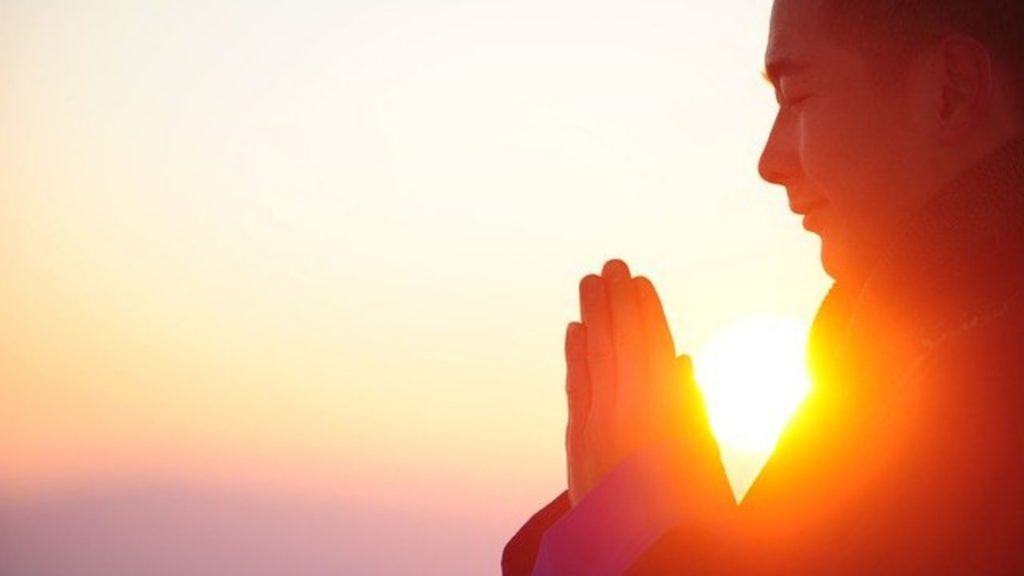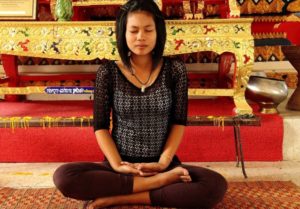Last Updated on July 31, 2023 by IncenseJunction
Meditation is a very important practice for anyone who wants to be more enlightened. It has proven to be a very effective practice in that respect. Over the years, different types of meditation have been developed.
Two of the common types of meditation you will find out there include Anapanasati and Vipassana. What is the difference between Anapanasati and vipassana? To be honest, the distinction between Anapanasati vs. vipassana should be well understood.
We have done all the necessary research and have prepared this short and informative post to help you understand how these two meditation styles differ from each other. Let’s dig deeper together.
About Anapanasati
This is a form of meditation that involves the use of mindful breathing to bring about a concentrated and serene mind. In this practice, the meditation allows the Buddha to awaken fully. This meditation is mainly concerned with the use of conscious breathing, which will calm your mind and allow it to analyze itself better, resulting in complete freedom.
Since breathing is the main focus of this meditation practice, you are required to focus fully on your lungs and the way they fill and empty the air. These sensations can be easily noticed after observing the way your abdomen, chest, or nostrils behave while breathing.
As your awareness of your breath increases and matures, it will extend to the entire body.
In simple words, you train your mind to focus on a single thing, in this case, your breath, so that your mind is not distracted. Each time you feel a distraction, you return your mind to the breathing sensations.
About Vipassana
Vipassana is a meditation technique that is mainly focused on observing emotions and thoughts in their raw form. You do not judge them or even dwell on them. One thing that we loved about this form of meditation is that it has been found to reduce anxiety and stress significantly. (See our best incense scents to reduce anxiety article)
When you start with this form of meditation, you are advised to start with sessions around 10 minutes long. As you continue to learn the meditation technique, you can increase the time to around 15 minutes. You can even go on for longer as you continue to learn this meditation.
While using this form of meditation, you can choose to play audio recordings, or even choose guided meditation in a class.
Anapanasati And Vipassana FAQs:
-
Is Vipassana Theravada or Mahayana?
This is a question that I’m often asked, and it’s one that I’m still trying to answer myself. I’m not a scholar of Buddhism, but I have been practicing Vipassana meditation for over 10 years, and I’ve been studying the Theravada and Mahayana traditions for almost as long.
In my opinion, the answer to this question depends on how you define “Theravada” and “Mahayana.” If you take a literal approach, then Vipassana is definitely Theravada. The word “vipassana” means “insight” in Pali, the language of the Theravada scriptures. And the Theravada tradition is all about developing insight into the true nature of reality.
But if you take a more inclusive approach, then Vipassana could be seen as part of the Mahayana tradition. The Mahayana tradition is about expanding our compassion to include all beings, and Vipassana meditation is a powerful tool for doing that. In fact, many of the great Mahayana teachers, like Dalai Lama and Thich Nhat Hanh, have been practicing and teaching Vipassana for decades.
So, ultimately, I think the answer to this question depends on your own personal definition of “Theravada” and “Mahayana.” If you see them as two separate traditions, then Vipassana is definitely Theravada. But if you see them as two sides of the same coin, then Vipassana is part of the Mahayana tradition.
-
Did the Buddha teach Anapanasati?
The Buddha taught that Anapanasati is a powerful tool for transforming the mind. Through the practice of Anapanasati, we can purify our minds of negative thoughts and emotions, and develop positive qualities such as concentration, compassion, and wisdom.
The Buddha also taught that Anapanasati is a path to liberation from suffering. By coming to a deeper understanding of the nature of the mind, we can see through the illusion of self and come to a place of true freedom.
-
Can I do vipassana before sleeping?
The answer is yes, you can do vipassana before sleeping. There are many benefits to practicing vipassana before sleep, including improved sleep quality, reduced stress and anxiety, and deeper insight into your own mind and body.
Vipassana is an ancient Buddhist meditation technique that means “insight” or “clear seeing.” It is a form of mindfulness meditation, which is a practice of paying attention to your present moment experience with an open and non-judgmental attitude.
Vipassana can be practiced at any time of day, but doing it before sleep can help you to wind down and relax into a restful state. When you’re trying to sleep, your mind is often racing with thoughts about the day’s events or worrying about what tomorrow will bring.
Practicing vipassana can help you to quiet your mind and focus on the present moment, letting go of those intrusive thoughts and worries. As you focus on your breath and the sensations in your body, you may find that you naturally drift off to sleep.
If you’re new to vipassana, there are many resources available to help you get started, including online courses, books, and audio recordings. Once you’ve learned the basics, you can practice vipassana anywhere and at any time, including before sleep.
-
Can you learn Vipassana at home?
One of the most common questions I get asked is whether it’s possible to learn Vipassana at home. The answer is yes and no.
On the one hand, Vipassana is an ancient meditation technique that has been passed down for thousands of years through an unbroken lineage of teachers. In order to learn it, you need to receive instruction from a qualified teacher.
On the other hand, the practice of Vipassana is not rocket science. It is simply the practice of mindfulness of the breath. And while it is true that the quality of your practice will be greatly enhanced by receiving instruction from a qualified teacher, it is also possible to learn the basics of the practice on your own.
So, if you’re interested in learning Vipassana, but don’t have access to a qualified teacher, what can you do?
There are a number of resources available online that can help you get started with the practice. I would recommend starting with the following two resources:
1. An Ancient Path: Talks on Vipassana Meditation as Taught by S.N. Goenka By Paul R. Fleischman
2. The Art of Living: Vipassana Meditation
These two resources will give you a good foundation in the practice of Vipassana. Once you’ve read and understood the basics, you can then begin to practice on your own.
If you find that you need more support in your practice, there are a number of online communities that you can join. The two that I would recommend are:
Both of these communities are supportive and friendly places where you can ask questions, get feedback, and connect with other practitioners.
So, there you have it. While it is certainly beneficial to receive instruction from a qualified teacher, it is also possible to learn the basics of Vipassana on your own. With a little effort and perseverance, you can develop a strong practice that will serve you well both on and off the meditation cushion.
-
Can I do Vipassana lying down?
Yes, you can do Vipassana lying down. In fact, there are several meditation techniques that involve lying down.
The traditional way to do Vipassana is to sit cross-legged and close your eyes. But there is no reason why you should not lie down if it’s more comfortable or you have a health condition that makes sitting impossible.
-
Can Vipassana cure anxiety?
When it comes to finding a way to cope with anxiety, there are many different options available. Some people may choose to see a therapist, while others may take medication. However, there is another option that is gaining popularity: Vipassana.
So, what is Vipassana? Put simply, it is a form of meditation that is said to help practitioners become more aware of their thoughts and feelings. This, in turn, is said to help them manage their anxiety in a more effective way.
There is a growing body of research that suggests Vipassana can be an effective treatment for anxiety. For example, one study found that Vipassana helped participants reduce their levels of anxiety and depression.
If you’re considering trying Vipassana to help you cope with anxiety, it’s important to speak to a qualified practitioner first. They will be able to give you more information about the technique and how it can help you.
-
Can Vipassana lead to enlightenment?
Yes, The practice of Vipassana is said to lead to enlightenment, or full awakening. This state is characterized by the complete eradication of mental impurities and the attainment of perfect peace and happiness. While there is no one path to enlightenment, the practice of Vipassana is said to be an effective means to achieve it.
The Buddha himself is said to have attained enlightenment through the practice of Vipassana. The goal of Vipassana is to develop insight into the true nature of reality. This is done by observing the mind and body with mindfulness and awareness.
-
Can Anapanasati lead to enlightenment?
Anapanasati, mindfulness of breathing, is a form of Buddhist meditation that dates back to the time of the Buddha himself. The Buddha taught that Anapanasati leads to enlightenment, and many modern practitioners find that it does just that.
Anapanasati is a way of bringing our attention to the present moment through breath. We simply observe the breath as it comes in and goes out, without judging or trying to control it. In this way, we learn to be more present and aware of our thoughts, emotions, and sensations.
The practice of Anapanasati can help us to develop a more positive outlook on life, and to become more patient, kind, and wise. It can also lead to deeper insights into the nature of reality and our place in it.
Also, read:
- Difference Between Shambhavi and Shoonya
- Is an Arahant a Buddha?
- Is ASMR As Good As Meditation?
- Difference between Vipassana and Shambhala Meditation Techniques
In Conclusion
Is anapanasati the same as vipassana? The difference is not quite clear when you think about it. When you compare Anapanasati vs. vipassana, you will realize that they almost have the same goal. Anapanasati aims at bringing peace to the mind of a person by calming it through breathing. Vipassana ends up bringing you wisdom or insight.
The reason why we say they have almost the same goal is that for you to reach vipassana’s goal, you will have to calm your mind, which is all Anapanasati. In a way, they are almost the same course, only for different levels. You will require both of these forms of meditation to achieve your goal.



